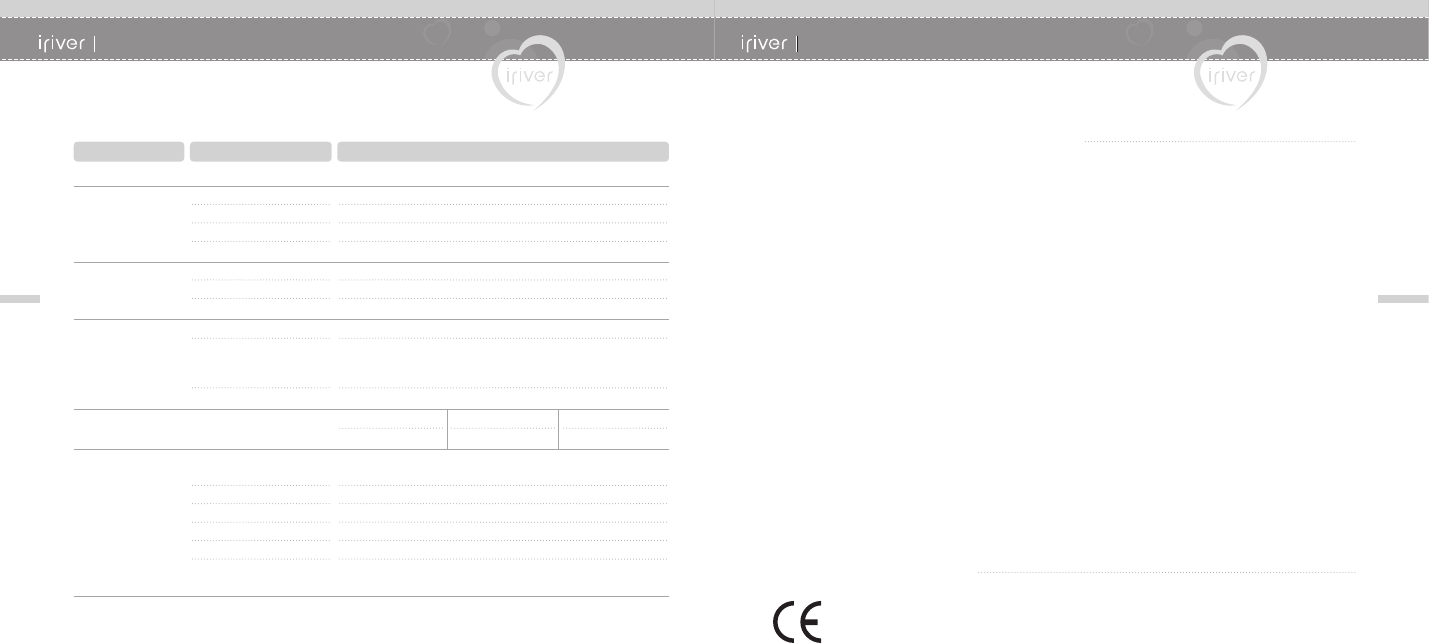
76
5 I Additional information
77
5 I Additional information
Specifications
Category
Memory Capacity N11 256MB* / N11 512MB* / N11 1GB*
Audio
Frequency range
Headphone Output
S/N ratio
Sound Channel
20Hz~20KHz
(L)14mW + (R)14mW (16Ω) max. Volume
90dB(MP3)
Stereo (Right/Left)
FM Tuner
FM Frequency
S/N ratio
Antenna
87.5MHz ~ 108MHz
60dB
Frequency range
File Playback
File Type
Bit Rate
Tag
MP3(MPEG 1/2/2.5 Layer3), WMA, OGG, ASF
MP3 : 8Kbps~320Kbps
WMA : 8Kbps~320Kbps
OGG : Q1~Q10
ID3 V1, ID3 V2 2.0, ID3 V2 3.0, ID3 V2 4.0
Recording
Max. Recording time
(@32kbps)
256MB
Approx. 18 hours
512MB
Approx. 36 hours
1GB
Approx. 72 hours
* 1MB = 1,000,000 Bytes, 1GB = 1,000 MB = 1,000,000,000 Bytes
Not all memories are available for storage.
Memory is not expandable.
General
Dimension
Weight
LCD
Battery
Operational Temperature
Max. Playtime
27.2 (W) X 49.8 (D) X 13.3 (H) mm (Body)
27.2 (W) X 62.5 (D) X 13.3 (H) mm (Including Type A earphone)
22 g (Body with Battery)
4 LINE OLED 16 GRAY
Lithium Polymer battery
-5 °C ~ 40 °C
Approx. 13 hours
(128 kbps, MP3, Vol 20, LCD off, EQ Normal)
Item Specifications
FCC
The CE mark on the CD player is valid only for products marketed
in the European Union.
The device manufactured and found to comply with limits for a Class B computing device according to
the specifications in FCC rules Part 15. Operation is subject to the following two conditions;
1. This device may not cause harmful interference.
2. This device must accept any interference received, including interference that may cause
undesired operation.
3. If your device needs repairs, you must arrange for the manufacturer to make them if you are
to keep the device's FCC registration valid.
This equipment, like other electronic equipment, generates and uses radio frequency energy.
If not installed and used according to the instructions in this manual, this equipment may cause
interference with your radio and television reception.
If you think this equipment is causing interference with your radio or television reception, try turning
the equipment off and on. If the interference problems stop when the equipment is switched off, then
the equipment is probably causing the interference. You may be able to correct the problem by doing
one or more of the following:
- Adjust the position of the radio or TV antenna
- Move away the device from the radio or TV
If necessary, consult your dealer or an experienced radio or television technician.
You may find this booklet helpful:"How to Identify and Resolve Radio and TV Interference Problems"
(Stock No. 004-000-00345-4), prepared by the FCC and available from the U.S Government Printing
Office, Washington, DC 20402. See individual devices FCC ID and registration numbers.
I Federal Communications Commission (FCC) I
I For the customers in Europe I


















